What is SEO Crawl Budget And Why Is It Important
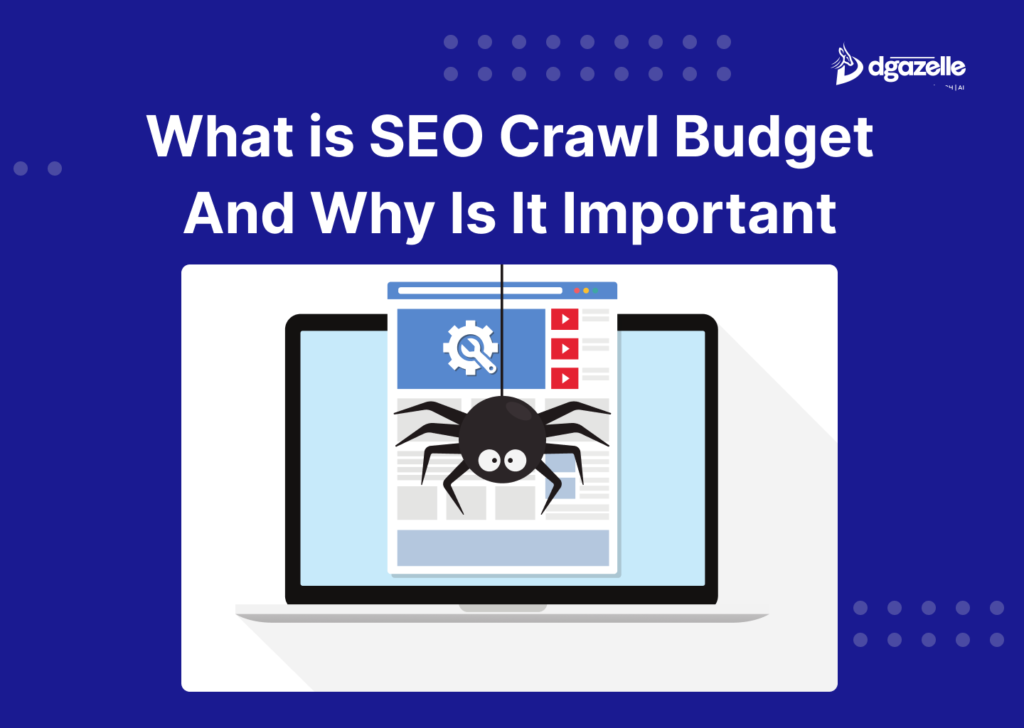
Understanding your website’s SEO crawl budget is crucial, especially for business owners in Nigeria looking to boost their online presence. In simple terms, crawl budget is the number of URLs on your website that search engines like Google will discover and crawl within a specific time frame. Once that quota is met, the search engine moves on to other sites. Here’s the thing: with billions of websites on the internet, search engines have limited resources. They can’t check every single site every day, so they prioritize which pages to crawl and when. This means that if your site isn’t optimized, important pages might not be indexed quickly or at all, potentially impacting your search rankings. For Nigerian businesses, ensuring that search engines efficiently crawl your site can lead to faster discovery of new content and improved visibility in search results. At Dgazelle, we understand the unique challenges and opportunities of the Nigerian market. That’s why our web design services not only focus on creating visually appealing and user-friendly websites but also incorporate best SEO practices. By designing your site with a clear crawl structure and optimized content, we help ensure that search engines find and index your pages effectively—giving your business the competitive edge it needs in the digital space. Before diving into the strategies that search engines use to decide what to crawl, let’s explore why managing your crawl budget is so vital for your site’s overall SEO success. Why is SEO Crawl Budget Important for your website? For your website to rank in Google’s search results, it first needs to be crawled and then indexed. This process allows Google to discover and store data about your pages, ultimately impacting their visibility. If something goes wrong with these processes, your content may never appear in search results. When Google’s web crawlers visit your site, they go through several steps: crawling pages, fetching data, storing it, and sending it back to the index. The efficiency of this process plays a significant role in your search rankings and can directly affect your organic traffic—ultimately impacting your business goals. For most website owners, crawl budget isn’t a major concern because Google is generally efficient at crawling sites. However, there are specific scenarios where understanding crawl budget becomes crucial for SEO performance: For Nigerian business owners, optimizing crawl budget is a way to ensure that your site remains competitive in search results, especially in a fast-growing digital market like Nigeria. At Dgazelle, we specialize in creating websites that not only look great but are technically sound to ensure efficient crawling by search engines. Our web design services focus on resolving potential crawlability issues and structuring your site for optimal performance. This means your content is more likely to rank higher, bringing you more visibility and ultimately driving business growth. By managing crawl budget effectively, you can ensure your content is indexed promptly, which leads to better search engine visibility and more organic traffic—vital for your business’ success in today’s competitive online landscape. How Does Google Determine Crawl Budget? Google determines your website’s crawl budget based on two primary factors: Crawl Demand and Crawl Capacity Limit. Understanding these factors can help Nigerian business owners optimize their site for better SEO performance. Optimize your site’s performance today with Dgazelle! Our expert web design services ensure better crawl efficiency and faster load times. Get in touch now! 1. Crawl Demand Crawl demand is how often Googlebot crawls your site, and it’s influenced by three key elements: 2. Crawl Capacity Limit Crawl capacity refers to how much Googlebot can crawl before your site’s performance is impacted. This is mainly determined by your website’s health and Google’s own crawling limits. For Nigerian business owners, it’s essential to maintain a healthy website to ensure smooth crawling. At Dgazelle, we prioritize website speed, server reliability, and SEO best practices to help ensure your site is easy for Googlebot to crawl, keeping your crawl budget intact. By understanding and managing these two factors, you can ensure that Google crawls your website efficiently, leading to faster indexing and improved SEO performance. This, in turn, can lead to higher search rankings and more organic traffic, helping your business thrive online. Why Should You Care About Crawl Budget? For Nigerian business owners aiming to enhance their online presence, understanding and optimizing crawl budget is essential. Here’s why: You want search engines like Google to find and understand as many of your indexable pages as possible. When you add new content or update existing pages, it’s crucial that search engines pick them up quickly. The sooner they’re indexed, the sooner you can start benefiting from that content through organic search traffic. However, if you’re not managing your crawl budget efficiently, Googlebot may waste time crawling unnecessary pages, leaving your important content undiscovered. If Google doesn’t know about your key pages, they won’t crawl and index them. This results in missed opportunities to attract visitors to those pages through search engines, which can severely impact your business’ SEO performance. Wasting crawl budget hurts your SEO, as search engines may not prioritize your essential pages, affecting your site’s ranking and visibility. But don’t worry—crawl budget management becomes particularly important if you have a large website (e.g., 10,000+ pages). For smaller sites, it’s typically not as big of a concern. Regardless, optimizing your crawl budget is a smart move for businesses of all sizes aiming for strong online visibility. Let Dgazelle help you create a website that’s built for search engines and users. Contact us for a strategy session! Tips for Crawl Budget Optimization Conclusion Regularly optimizing your site’s technical aspects ensures web crawlers can efficiently find your content, which is essential for ranking in search results. By using tools like Semrush’s Site Audit, you can monitor your site’s health and address errors before they impact performance. This proactive approach helps you maximize your crawl budget, improve SEO, and ultimately boost your site’s visibility. Maximize your crawl budget with a high-performance website from Dgazelle. Our team ensures
Orphan Pages Killing Your SEO? Here’s How to Find and Fix Them
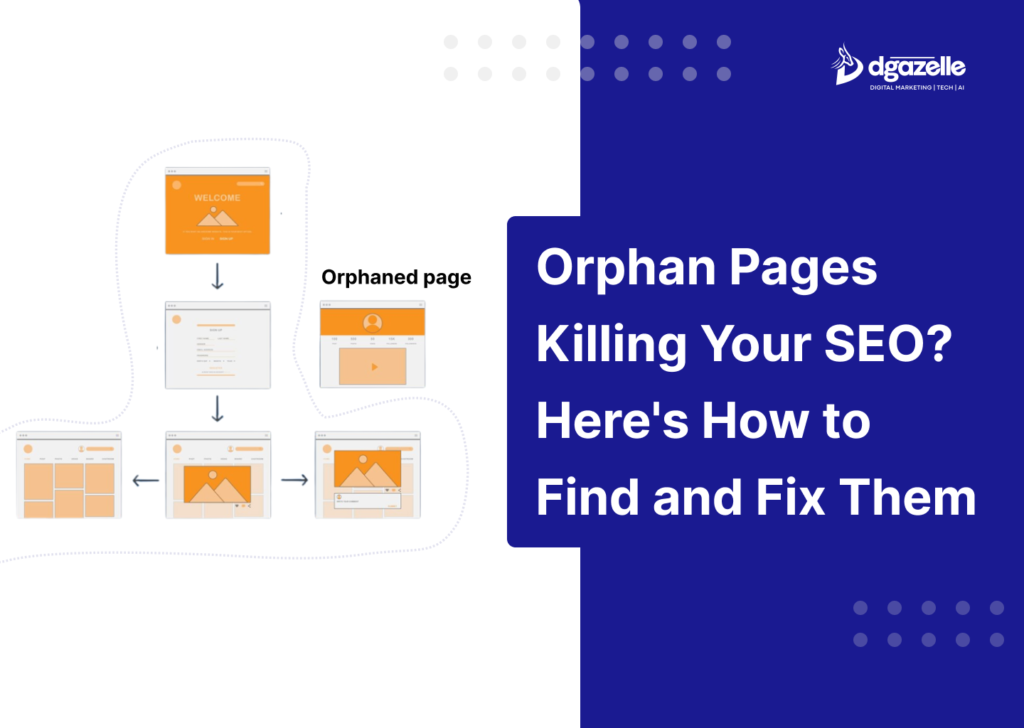
When we talk about orphan pages, we’re referring to web pages that exist on your site but aren’t linked to from any other page. This means users and search engines have a hard time finding them. For Nigerian SME owners, this is crucial because if potential customers can’t discover your best content, you’re missing out on sales and visibility. Orphan pages aren’t necessarily bad for SEO, but they don’t contribute to your site’s overall content strategy. You could have top-notch content on these pages, but without internal links guiding users and search engines to them, they serve little purpose. Sometimes, orphan pages are created intentionally—like landing pages used in paid ads. These pages are usually set up to be hidden from search engines with tags like “noindex, nofollow,” which is perfectly fine. But for your main website, every valuable page should be easy to find and accessible to users and search engines. What Exactly Are Orphan Pages? Orphan pages are web pages on your site that have no internal links pointing to them from any other page—be it your homepage, blog posts, category pages, or navigation menu. This means users and search engines can’t easily discover them. But it goes beyond that. If a page is only linked from other orphan pages, it’s still considered an orphan. For example, if Blog Posts B and C are linked only from Post A, and Post A itself is orphaned, then B and C are also orphans. They’re isolated from the main site structure, making them invisible to search engines and users navigating from your homepage. For Nigerian SMEs, this can be a big problem. Hidden pages mean missed business opportunities, as potential customers won’t find your valuable content or products. When Is It Okay to Have Orphan Pages? Not all orphan pages are bad. In fact, some are intentional. These include: These pages are usually hidden from search engines with “noindex, nofollow” tags and don’t need to be part of your main site structure. As long as this is strategic and intentional, it’s perfectly fine. What Causes Orphan Pages? Orphan pages often occur unintentionally, but they can also be deliberate.Common Causes Include: Intentional Orphan Pages:Some orphan pages are purposefully isolated, like: As long as these are strategic, they’re okay. Just make sure they’re excluded from search engine indexing. Why Are Orphan Pages Bad for SEO? Google and other search engines discover new content by following internal links. If a page is orphaned, search engines won’t find it unless it’s in your sitemap or has backlinks. No Internal Links = No PageRankPageRank is Google’s way of understanding a page’s importance based on the number and quality of links pointing to it. Without internal links, an orphan page can’t receive any “link juice” or PageRank, impacting its SEO performance. For Nigerian SMEs, this means valuable content or product pages could be hidden from potential customers, ultimately affecting your bottom line. How to Find Orphan Pages on Your Website Finding orphan pages requires a thorough approach using multiple tools and methods. Here’s how to get it done: 1. Using SEO Crawling Tools These tools can identify orphan pages even if they’re not linked internally by comparing the site’s crawl data with your sitemap. Combining these tools provides a comprehensive view of orphan pages on your site. 2. Using GA4 and Search Console This approach also helps discover low-performing pages for future content improvement. 3. Manual Site Audit This is the most accurate but time-consuming method. Hiring a dedicated SEO Agency to help keep on top of things like this could also save you time. The experience they have will mean they are always looking out not just for issues with orphan pages, but hundreds of other things that could also be impacting your organic visibility. 4. Backlink Analysis Tools to Use: How to Fix Orphan Pages on Your Website Once you’ve identified the orphan pages, fixing them is straightforward. Here are two effective methods: 1. Adding Internal Links If the orphan page is valuable and relevant: 2. Remove and Redirect If the orphan page is outdated or no longer relevant: Why It Matters: A 301 redirect preserves link equity and ensures users land on a relevant page, maintaining a positive user experience. Conclusion All content on your website should have a purpose for both users and SEO. If a page is orphaned it becomes arguably useless for them both. If you have any other methods you use for finding orphan pages, we’d love to hear them. Boost your online presence and grow your business with Dgazelle’s expert social media and digital marketing services. From creative strategies to tailored campaigns, we’ve got you covered.
Want More Visibility on Facebook? 8 Simple Hack That Can Help You Beat the Algorithm!
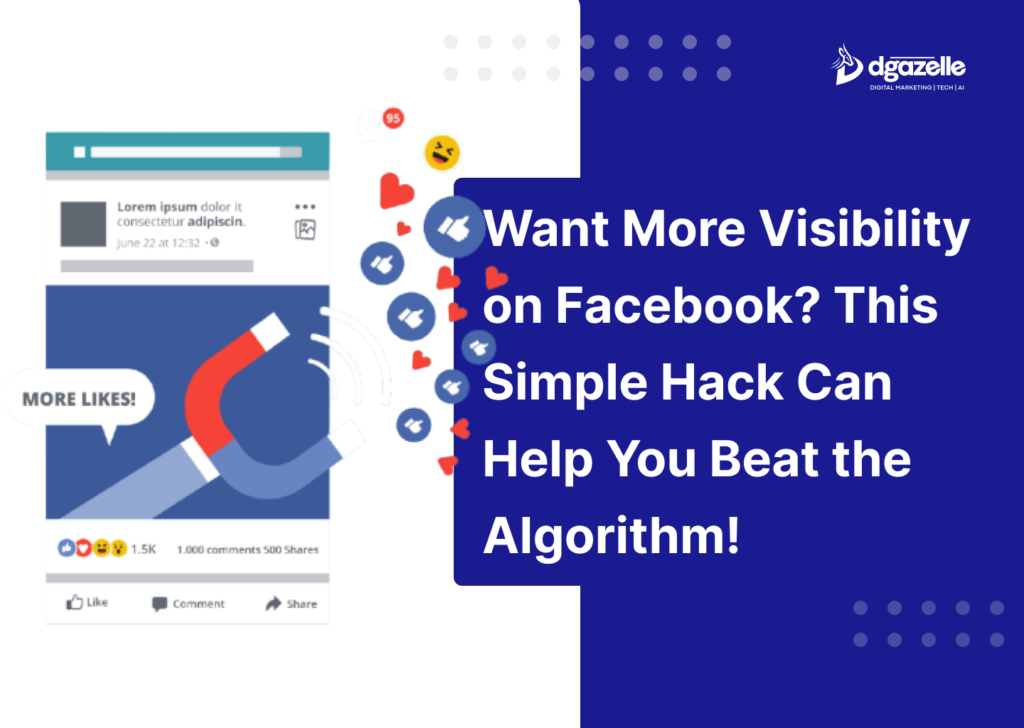
Remember when posting a single link on Facebook could drive hundreds of clicks to your website? It felt like magic—simple, effective, and exciting. But those golden days are long gone. Today, social media referrals account for just around 5% of all website traffic, and the average Face-book post barely reaches 5% of your followers. Algorithms have changed, and organic reach has plummeted, leaving businesses scrambling to be seen. But here’s the good news: social media is still a powerful tool. With over 3.96 billion active users globally, including a thriving community in Nigeria, there are untapped opportunities for growth—if you know how to navigate the landscape. So how can Nigerian SMEs stay ahead without breaking the bank on ads? At Dgazelle, we understand the struggle to remain visible in a saturated digital world. That’s why we specialize in creating tailored social media strategies that help Nigerian SMEs stand out organically. Ready to grow your audience and beat the algorithm? Let’s help you make that happen. What is Facebook Reach? In social media terms, reach refers to the number of unique people who see your post. This differs from impressions, which count how many times a post is seen, including multiple views by the same person. Post Reach: The number of unique users who saw a specific post. Page Reach: A broader measure showing how many people viewed any content related to your page over time. Post reach can be further divided into: Given the sharp decline in organic reach, engagement becomes critical. Posts that attract likes, comments, shares, and interactions are favored by algorithms, naturally boosting visibility. Let us show you how smart content and engagement strategies can help you beat the algorithm blues. Here’s a refined and engaging version of the content with a focus on Nigerian SMEs: Why Facebook Organic Reach Is Declining — And What Nigerian SMEs Can Do Two major factors have led to the steady decline of organic reach on Face-book: So, Can Nigerian Businesses Still Thrive? Absolutely. Facebook remains a powerful platform with a massive audience, even for organic traffic. The key lies in adopting smart strategies that cut through the clutter. While Face.book ads (with over 10 million advertisers) offer great opportunities, organic reach still matters. Together, they can work hand in hand to deliver better results. Here’s a compelling and clean version, blending the sections cohesively while keeping the nostalgic yet informative tone: Simple Hacks to Boost Organic Reach for Nigerian SMEs on Face book Now that we’ve got the basics out of the way, let’s dive into some actionable tips: 1. Mix Up Your Post Formats Don’t get stuck using just one type of post. Experiment with a variety of formats—images, videos, polls, and even link posts. If your images aren’t getting the traction you want, switch to videos and observe how they perform. Social media managers believe Facebook favors newer post types in the News Feed, such as Stories or 360 videos. Track the reach of each format over time to find out what resonates with your audience best. 2. Go Live and Be Authentic! Live videos and Stories create a strong sense of community. Everyone watching shares the same moment, often sparking meaningful interactions in the comments. Since Facebook prioritizes these interactions, authentic live videos can extend your organic reach. Get creative, share stories, or engage viewers directly. 3. Use Eye-Catching Images and Videos Visual content is essential. Studies show posts with images get 2.3x more engagement than text-only content. Even if you don’t have a professional camera, smartphones work just fine. Ensure your visuals are well-lit, focused, and with clear audio. High-quality content maintains your brand reputation. By staying creative and consistent with these strategies, Nigerian SMEs can still thrive organically despite Facebook’s algorithm changes. Want help navigating these changes? Let’s connect at Dgazelle. 4. Get Verified on Face book The blue verification badge proves your Page is the official representation of your brand, distinguishing it from copycats and boosting authenticity. Benefits include higher search rankings, greater trust from followers, and improved visibility. To get verified: 5. Engage Your Team Facebook favors meaningful interactions, and having your team engage with company posts increases your reach. Tips for team engagement: 6.Optimize Your Link Posts Sharing content through link posts is common, but the quality of your links directly affects their visibility on Facebook. Face book prioritizes link posts that lead to fast-loading pages and penalizes those with poor user experiences. The more people click your link and engage with your post afterward, the higher your post ranks. 7. Make Your Audience Feel Something Never beg for reactions; instead, create posts that evoke emotions naturally. Emotional engagement significantly increases shares, reactions, and comments, ultimately boosting organic reach. Tips for Emotional Content: According to Harvard Business Review, positive emotions often drive viral posts, but anticipation and surprise from negative emotions can work too. Focus on themes like curiosity, amazement, and admiration. 8. Start a Contest Running a contest or sweepstakes can be a powerful way to attract user interaction and boost organic reach. After all, who doesn’t love free stuff? Best Practices for Face book Contests: By fostering meaningful interactions through creative contests and emotionally engaging posts, your content is more likely to rise to the top of News Feeds, extending your reach organically. Conclusion Facebook is a brilliant marketing tool—there’s no doubt about that. The number of businesses actively using the platform continues to grow year over year. However, the influx of published content has led to a decline in organic reach, creating fierce competition for News Feed space. What was once automated now demands more effort and due diligence. Will organic reach continue to plummet, or will it improve? Nobody knows. Regardless, your task remains the same—get creative with social media marketing and consistently provide high-quality content. By implementing the hacks shared here, you’ll improve your chances of extending your organic reach on Facebook. You’ll also become more adept at navigating the platform’s ever-evolving landscape. Boost your online
Marketing That Works, Even Without a Solid Social Media Presence
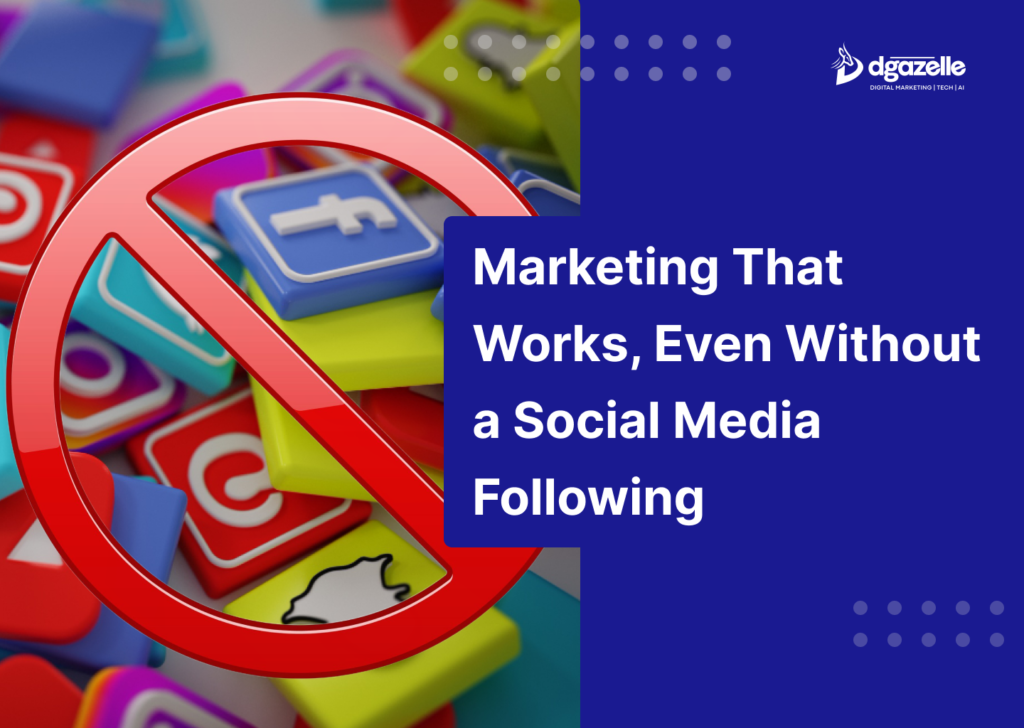
Running an online business without social media presence? Sounds like the punchline of a joke, right? Let’s be real — quitting social media can feel like stepping off a cliff without a parachute. You might wonder, “How will I get leads for my business? What happens to my marketing now?” That’s exactly why we’re here — to craft a foolproof marketing strategy that doesn’t rely on social media but still drives growth, conversions, and engagement. Imagine confidently saying goodbye to endless posting, algorithm battles, and burnout — without a single backward glance. To be clear, none of us at Dgazelle are against using social media. It can be a source of fantastic connections, a creative outlet, or just plain fun to use. In fact, several of my own closest real life friends I met on Twitter years ago! However, social media is absolutely not necessary to build and grow a successful business in 2025. Many SMEs have built successful brands by leveraging alternative digital marketing strategies — and you can too. Finding the Right Marketing Strategy for Your Business (Without Social Media) You can’t stepped away from Instagram, Facebook, and all the rest, without having solid marketing strategies already in place. So before you say “Adios” to Instagram, Facebook, X, or TikTok, it’s crucial to ask yourself: What marketing strategy will replace social media? What foundations will you start building today so that you’re ready for tomorrow? Let’s make this decision intentionally. You’re investing time, money, and energy into a strategy that could serve your business for years. Just like financial investments, marketing requires strategic thinking. Imagine standing at a financial crossroads: Choosing between these isn’t about “crypto versus real estate.” It’s about understanding your overall investment strategy — what’s your risk tolerance, desired involvement, and long-term goals? The same goes for choosing marketing strategies: Email marketing, SEO, and traditional advertising are all tools — but your decision hinges on your business objectives and audience needs. By starting with a clear strategy, you’ll select the right marketing tools and confidently say goodbye to social media without scrambling back months later because you’re desperate for leads. So, here’s the game plan: define your strategy, then pick your tools. Social media is just one option — but for you, it’s off the table. Ready to build a thriving business without social media? Let’s explore various approach. 1. Ask for Referrals Never underestimate the power of a good referral. Happy clients can become your biggest marketing allies. Here’s how to leverage this strategy: For instance, I’ve landed multiple projects just by asking satisfied clients to refer me to their networks. Referrals are proof that word-of-mouth marketing still works wonders. 2. Create an SEO-Friendly Website A website is your business’s permanent address online, driving credibility, trust, and visibility. In fact, SEO drives over 1,000% more traffic than organic social media, with 68% of online experiences starting with a search engine. Key benefits of having a website: Don’t have a website yet? Start simple on platforms like WordPress, which offers beginner-friendly templates and self-hosting. Or invest in a professional website developer for a more robust solution. 3. Blog Consistently Once your website is up, consistent blogging becomes a powerful tool to drive traffic and conversions. Valuable blog content helps you rank on search engines, offering solutions your audience is actively searching for. Over time, I found that blog articles led to higher conversions. Why? People searching on Google are often ready to buy, unlike social media users who are in a passive browsing state. Consider your own behavior: when searching for services or products, do you rely on social media or Google? Most turn to Google with queries like “budget-friendly travel destinations” or “clean skincare products.” Blogging positions your brand to appear on search results and answer user queries, guiding readers toward your offers. 4. Host Workshops Workshops allow you to showcase your expertise, raise brand awareness, and attract potential clients or customers. You can lead your own workshop or collaborate with other businesses. For example, as an SEO consultant, I might host a workshop on “How to Grow Your Business with Website SEO.” Here are other workshop ideas based on business types: Hosting workshops provides value to your audience while positioning you as an industry leader. 5. Pitch Podcasts Did you know 40% of podcast listeners make purchases after hearing recommendations on a podcast? Pitching podcasts with relevant audiences can elevate your brand visibility. When featured, you typically share insights, answer questions, and promote offers at the end of the episode. Tips for a successful pitch: Being authentic and engaging on podcasts builds trust and connects you with potential clients or customers. How to Grow a Business Without Social Media Step 1: Evaluate Your “Why”Reflect on why you want to grow your business without social media.Common challenges include: If you’re seeking diverse lead sources, feel burnt out by social media, or have seen poor ROI, exploring alternatives may be beneficial. Step 2: Understand Your Audience DeeplyKnowing your audience’s problems and aspirations is key to effective off-social marketing. Exercise: Visualize your ideal client who achieved great results. This exercise provides insights for tailored messaging and offers. Step 3: Develop a Body of WorkCreate foundational content to establish your authority. Steps to build authority: Step 4: Build an SEO-Based Marketing FunnelDid you know 90% of online experiences start with search engines? Ignoring search limits your reach. Here’s how a search-focused funnel works: Keep it simple. Don’t overcomplicate the process—focus on solving searchers’ problems. Step 5: Build Referral NetworksNetworking with both colleagues and competitors is a powerful, overlooked strategy. Tips for building referrals: A strong referral network can drive high-quality business from aligned clients. Step 6: Experiment and Track Metrics for Non-Social MarketingFear of trying new marketing strategies often stems from uncertainty. However, experimenting allows you to gather valuable data, helping refine your approach over time. Tips: Data-driven experiments reduce the guesswork in your marketing journey. Step 7: Collect Data and Refine StrategiesAfter at least 90
Programmatic SEO Made Simple: Transform Your Approach to Search Engine Strategy
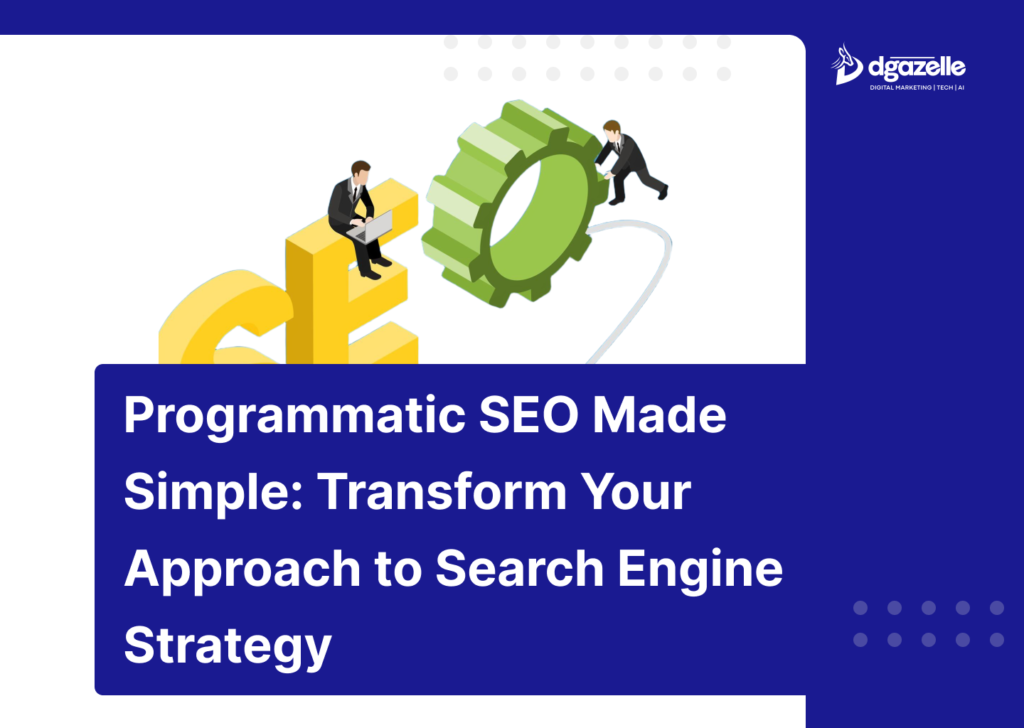
Ever wondered how some websites effortlessly rank for thousands of keywords without a huge content team? That’s the magic of programmatic SEO. With AI increasingly on the rise, automation are game-changers. Programmatic SEO empowers businesses to generate hundreds—even thousands—of optimized pages at scale, saving valuable time while driving significant search visibility. Instead of relying solely on manual tactics, it uses data-driven insights to spot trends, automate optimization, and boost results. But here’s the catch—it’s not for everyone. To unlock its full potential, you need a clear strategy tailored to your business goals. Looking to outsmart your competitors with smarter, scalable SEO tactics? Partner with our digital marketing experts to craft a winning programmatic SEO strategy designed to amplify your search rankings and drive growth. What is Programmatic SEO? Programmatic SEO is an approach to search engine optimization that uses automation to create large numbers of pages, each targeting specific, low-competition keywords. For instance, travel aggregator sites like Expedia effectively use programmatic SEO by generating location-specific pages for flights, hotels, and tourist activities based on structured data. Unlike traditional SEO, where content is manually crafted for each keyword, programmatic SEO relies on templates and automation tools to generate hundreds—or even thousands—of pages at scale. This method is particularly useful for businesses offering a wide range of products, services, or content topics. What’s made programmatic SEO even more accessible today is the rise of AI and automation tools like GPT-4, Frase, and SurferSEO. GPT-4 helps generate detailed base content efficiently, Frase aligns it with user intent to improve engagement, and SurferSEO provides data-driven keyword insights to optimize content performance. When executed with the right data and automation setup, programmatic SEO can drive serious traffic at scale. Summarizing the advantages of automation and data-driven insights, it’s important to acknowledge potential downsides. Programmatic SEO isn’t for everyone. It works best for websites that provide unique, relevant data across a large set of similar keywords. Without quality data and a clear strategy, thin, low-value content can harm your rankings instead of boosting them. To mitigate this risk, prioritize high-quality content by using robust templates, incorporating user-focused information, and maintaining data accuracy. Programmatic SEO vs. Traditional SEO The key difference between programmatic SEO and traditional SEO lies in execution and scalability—both of which have implications for small and medium-sized enterprises (SMEs). Traditional SEO focuses on crafting high-quality, targeted content for individual keywords through meticulous user research, manual content updates, and in-depth optimization. This hands-on approach aims to satisfy search intent for highly specific queries, often requiring significant time and creative resources. On the other hand, programmatic SEO is designed for efficiency and scale. Instead of manually creating pages for each keyword, businesses develop templates and use automation to generate hundreds or even thousands of pages targeting long-tail keywords. This approach works particularly well for SMEs managing diverse product catalogs, service directories, or niche content categories. For example, an SME running an e-commerce store can use programmatic SEO to create dynamic product pages that incorporate essential elements like pricing, customer reviews, and specifications. Similarly, a real estate directory can generate location-specific listings by leveraging structured data. Both approaches hinge on strong keyword research—without it, any SEO effort will falter. However, programmatic SEO requires additional attention to data accuracy and content quality to prevent thin, low-value pages. SMEs adopting this strategy should ensure their content templates provide meaningful user experiences and valuable information. Here’s a refined version of the “Potential Benefits of Programmatic SEO” section optimized for SEO and SME business owners: Benefits of Programmatic SEO One of the most impactful advantages of programmatic SEO is its efficiency. For SMEs with limited time and resources, this approach offers a way to generate a vast number of keyword-focused pages without the heavy cost of manual content creation. Automation allows you to scale up and create hundreds or even thousands of pages quickly, saving valuable time and operational expenses. This approach also helps capture organic traffic that competitors might overlook by targeting low-competition, niche keywords. For example, a local service provider or product-based business can create pages optimized for specific locations or services, expanding their reach and authority across multiple regions. Moreover, programmatic SEO boosts your website’s visibility. By increasing the number of indexed pages, businesses gain more opportunities to appear in search results, attract new customers, and establish their online authority. When executed strategically, it can complement traditional SEO efforts and maximize your site’s organic growth potential. How to Set up Programmatic SEO Now that you’re familiar with programmatic SEO, let’s break down an actionable, step-by-step process to help SMEs efficiently scale their search visibility. With the right approach, this method becomes manageable and highly rewarding. 1. Identify Strategic Keywords Effective programmatic SEO begins with smart keyword research. Identify niche, low-competition long-tail keywords relevant to your industry. Tools like Ubersuggest or SEMrush are valuable for generating keyword lists. For SMEs, focus on terms with high purchase intent or location-based searches, such as “affordable marketing services in [city]” or “best digital tools for [sector].” 2. Create Flexible Page Templates Develop a template for dynamic page creation. Keep it clean and user-friendly, with placeholders for elements like product prices, service descriptions, or city-based content. This template becomes the framework for generating multiple SEO-optimized pages while maintaining consistent branding and functionality. 3. Leverage High-Quality Data Sources Accurate, relevant data elevates your pages. SMEs can use internal databases, publicly available datasets, or carefully vetted external sources to populate dynamic content fields. Ensure your data stays up to date—whether it’s pricing, locations, or service descriptions—to maintain user engagement and search relevance. 4. Automate Page Generation Automation is the heart of programmatic SEO. Use tools like Google Sheets combined with WordPress plugins (e.g., WP All Import) or Webflow to dynamically populate page templates. This process can help SMEs create hundreds of keyword-focused pages quickly, without sacrificing consistency or functionality. 5. Optimize and Improve Continuously Automation doesn’t mean set-and-forget. Regularly review metrics like bounce rate, average time on page, and CTR to identify areas for
Facebook Ads 2025: How Much Should You Really Be Spending?
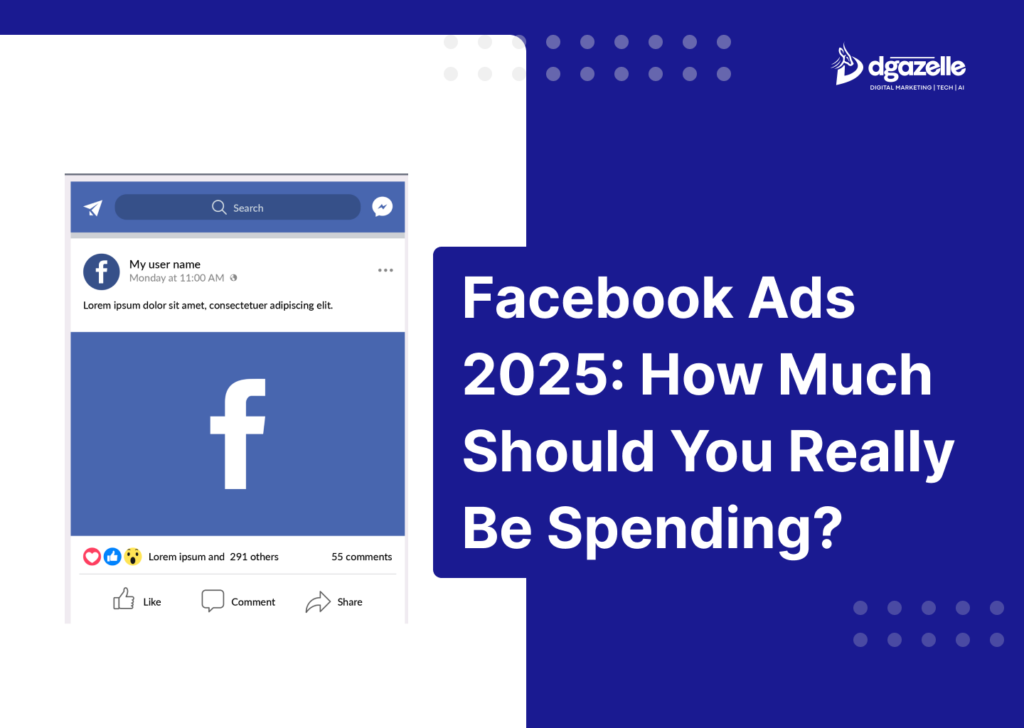
Marketers worldwide voted for Facebook as the advertising platform with the best ROI in 2024 and chance of it being the best in 2025 is high. However, managing your Facebook Ads budget has become increasingly challenging due to rising costs and evolving audience behaviors. For Nigerian small business owners, these budget concerns are even more significant as every naira spent on advertising must count. So, how do you effectively allocate your budget and get the returns you need without overspending? Why Should You Have a Facebook Ad Spending Strategy? Is investing in Facebook ads really worth it for your small business in Nigeria? The answer depends on having a smart, intentional ad spending strategy. Your marketing budget is an investment meant to drive growth and revenue, so aligning your ad spending strategy with your business goals is crucial. This means determining how much you’re willing to spend and ensuring it directly contributes to measurable objectives like lead generation, conversions, or brand awareness. At Dgazelle Digital, we help small businesses develop customized, data-driven Facebook ad strategies designed to maximize returns and achieve sustainable growth. Ready to build smarter ad strategies? Stay tuned for actionable steps tailored to your budget and business size! Factors That Determine the Cost of Facebook Ads If you’re running Facebook Ads for your small business in Nigeria, understanding cost influencers is crucial for optimizing your budget. There’s no one-size-fits-all budget. Many Nigerian SMEs allocate between ₦20,000 to ₦100,000 per month, scaling as returns improve. The key is to spend wisely, learn from data, and keep optimizing. Here are key factors to consider: How Much Should You Spend on Facebook Ads? Spending on Facebook Ads should be strategic and aligned with your business goals. Below is a practical guide for SMEs in Nigeria: Step 1: Define Your Campaign Goals Your objectives determine how much you should spend and where to focus your budget. Here are the six campaign objectives on Facebook: For small businesses, conversion-focused objectives like Sales and Leads often deliver the best results by providing measurable ROI. Step 2: Start Small and Test the Waters Resist the urge to start big. Begin with a modest budget and scale only after gathering sufficient performance insights. Smart spending and ongoing optimization will help you achieve sustainable business growth while minimizing wasted ad spend. Step 3: Base Your Budget on Audience Size Understanding your audience size helps in setting a realistic budget. Targeting a niche audience often yields more impactful results. Step 4: Adjust Your Budget as You Scale Once you’ve identified what works, gradually increase spending and refine your targeting. Leveraging AI tools like Madgicx Ads Manager 2.0 can help optimize campaigns and manage budgets without restarting the learning phase. Summary Effective Facebook ad spending requires strategic planning, audience targeting, and continuous optimization. Factors like campaign goals, budget adjustments, and the right tools, play a crucial role in maximizing ROI. Ready to supercharge your Facebook ads? Partner with our digital marketing experts for data-driven strategies, optimized spending, and impactful results. Let’s take your campaigns to the next level!
Dgazelle Digital Welcomes Nkem Offonabo as Brand Ambassador: A Perfect Partnership for digital transformation and work-life harmony.

Dgazelle Digital announces Nkem Offonabo, CEO of The Work-Life Organisation, as our new Brand Ambassador. Learn about this exciting partnership and how it aims to inspire and empower businesses and professionals to grow.
Combat Ad Fatigue: Data-Driven Strategies to Keep Your Ads Converting in 2025
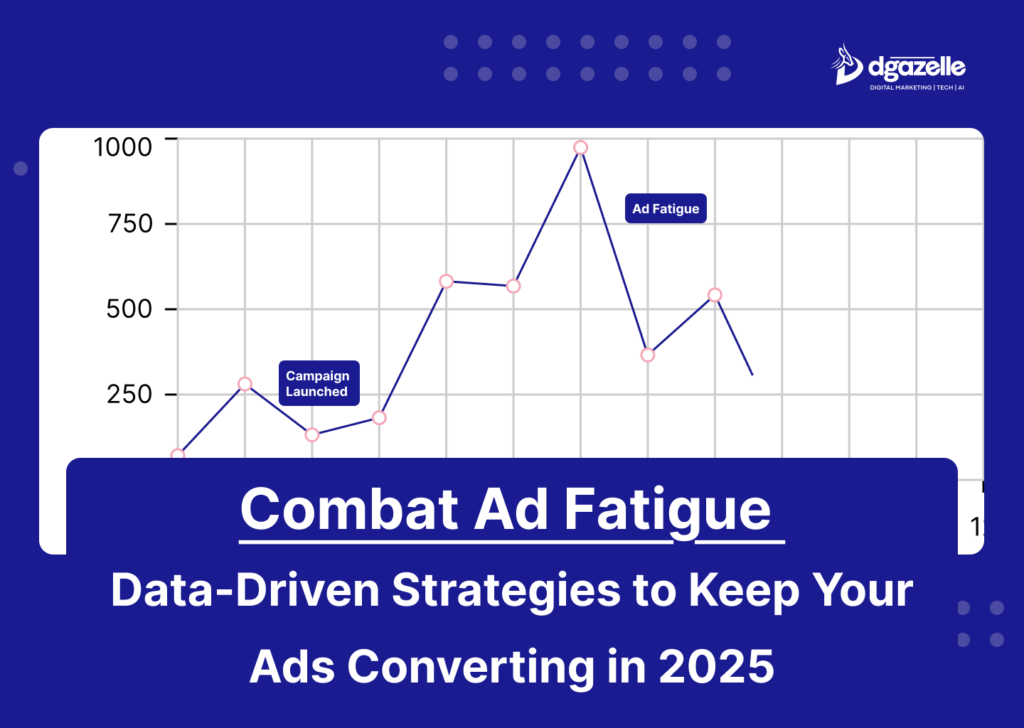
Nigeria digital marketing is really competitive and, keeping your ads engaging is crucial, especially for small business owners leveraging social media platforms like Facebook and Instagram. Ad fatigue can hinder your campaign success, causing disengagement, lower sales, and decreased ad performance. Ad fatigue occurs when your audience repeatedly sees the same ad, leading to a decline in click-through rates (CTR), conversions, and rising costs. This is a common issue that disrupts even the most well-planned campaigns, making it essential to recognize and combat it. This guide is designed for Nigerian small businesses, offering practical, data-driven strategies to keep your ads converting in 2025. Whether you’re running Marketing Services or handling PPC campaigns, understanding and managing ad fatigue is vital to maintaining high ROI. Understood! Here’s the streamlined and SEO-optimized version of the provided section, tailored to small business owners in Nigeria: Understanding Ad Fatigue Ad fatigue occurs when your audience loses interest in an ad after seeing it too many times. It’s like hearing your favorite song on repeat—initially exciting, but eventually, you start ignoring it. On platforms like Facebook and Instagram, this results in lower engagement, reduced conversions, and rising costs for Nigerian small businesses. Repetitive exposure to the same ad can cause audiences to tune out. Just like a song you’ve heard too often, ads lose their appeal when they’re shown too frequently without variation. This natural consequence of overexposure makes it harder for small businesses to capture attention and maintain conversions. What Causes Ad Fatigue? Several factors contribute to ad fatigue: These issues can reduce engagement and hurt your brand’s image, making it more difficult to achieve sustainable growth on platforms like Facebook and Instagram. Why Ad Fatigue Matters for Nigerian Small BusinessesOn platforms like Facebook and Instagram, ad fatigue can hurt your business’ performance. It leads to: Recognizing ad fatigue and addressing it early is essential for maintaining a high-performing marketing strategy in Nigeria’s competitive digital space. Here’s the revised and SEO-optimized version of the section, tailored for small business owners in Nigeria and focused on platforms like Facebook and Instagram: Signs You’re Experiencing Ad Fatigue Identifying ad fatigue early can save your campaigns from declining performance. Here are six key signs Nigerian small business owners should watch for on platforms like Facebook and Instagram: Proactively addressing these signs will help your business maximize returns on platforms like Facebook and Instagram. Here’s the optimized version of your section, tailored for platforms like Facebook and Instagram with the standing instructions: Combatting Ad Fatigue Once you’ve identified ad fatigue in your campaigns, it’s time to take action. Here’s a proven three-part framework to resolve it: Creative, Campaign, and Channel. Creative The most common culprit for ad fatigue is your creative. Even if your team poured time and resources into crafting a “perfect” asset, one creative won’t cut it in today’s fast-paced world of performance marketing. Instead, aim for variety—launch multiple creative types with diverse styles, imagery, and hooks to keep audiences engaged. Dynamic product ads (DPAs) are a cost-effective way to generate creative at scale. These ads dynamically pull product details, such as images, names, and prices, from your catalog. Enhanced catalog ads let you experiment with different CTAs and on-brand designs while launching multiple ads simultaneously. By diversifying your creative, you’ll intercept potential customers as they scroll through competitive feeds like Instagram Stories or Facebook Reels. Campaign If creative tweaks don’t improve performance, assess your campaign mix. On platforms like Meta, ensure your campaigns leverage diverse audiences and placements. You can: Automated campaign tools like Advantage+ streamline testing across audiences and placements while supporting dynamic product ads, making them powerful tools against ad fatigue. Channel If creative and campaign tweaks fail, it’s time to test new channels. Diversify by exploring platforms like TikTok, Snapchat, or Pinterest. These platforms can introduce your brand to fresh audiences, provide unique placements, and inspire creative innovation. This strategy ensures your campaigns stay relevant and engaging across platforms like Facebook and Instagram, maximizing ROI and combating ad fatigue effectively. Conclusion Ad fatigue may seem daunting, but understanding its causes and signs is your first step to overcoming it. By staying vigilant with performance metrics, engagement rates, and ad frequency, you can address issues before they harm your campaigns. Implementing a strong experimentation framework—focusing on Creative, Campaign, and Channel—is essential for keeping your ads fresh and engaging. From refreshing visuals to testing new platforms, proactive strategies help maintain audience interest and maximize ROI. Remember, data-driven decisions are your strongest ally. Use insights to optimize your campaigns continuously, and don’t hesitate to explore dynamic product ads for scalable creative solutions. Stay adaptable, and you’ll keep ad fatigue at bay while achieving your marketing goals. Ready to revamp your campaigns and keep your audience engaged? Let Dgazelle’s expert digital marketing services take your ads to the next level. From creative refreshes to data-driven strategies, we’ll help you combat ad fatigue and drive meaningful results.
Core Web Vitals in 2025: The New Metrics You Can’t Ignore
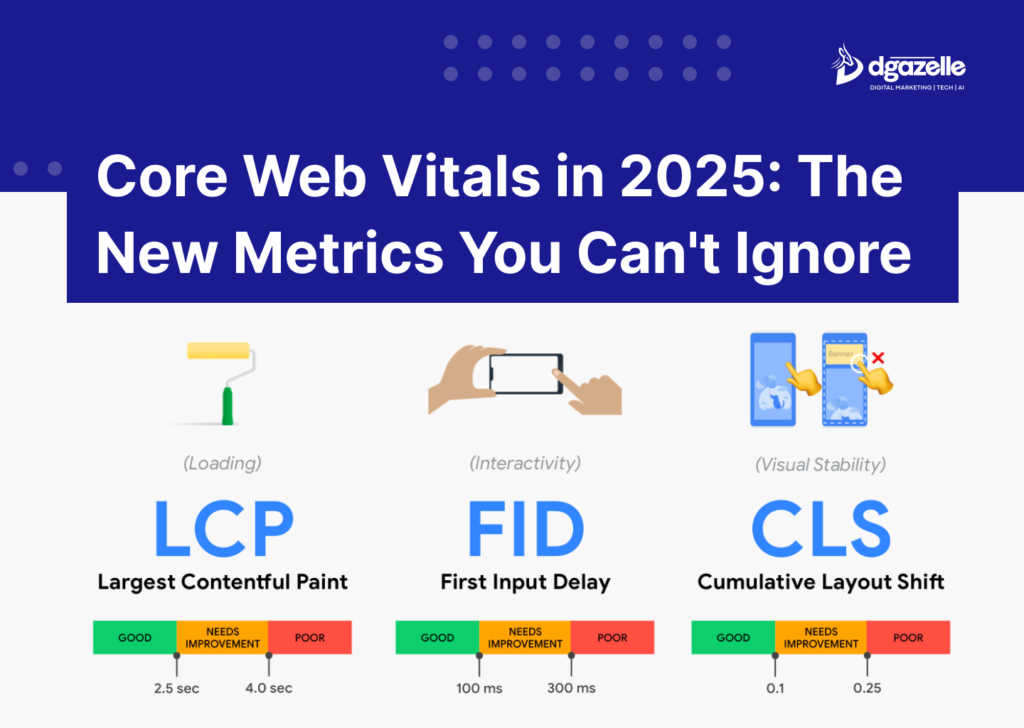
We live in a world, where every second counts and so is it on your website too. Your site’s speed, stability, and responsiveness are more than technical details—they define the quality of your visitors’ experience. For small businesses in Nigeria, where competition is fierce, getting this right is critical. Google’s Core Web Vitals focus on three key aspects: Loading Speed, Layout Stability, and Responsiveness. These metrics have become essential benchmarks for ranking and user satisfaction. Optimizing for Core Web Vitals in 2025 isn’t just about staying competitive; it’s about thriving online. While we often prioritize keywords, mobile optimization, and backlinks, Google emphasizes on-page experience. Core Web Vitals measure how well your site loads, responds to actions, and maintains visual stability. This guide simplifies these evolving metrics and highlights their impact on small business rankings. Learn how to deliver a stellar user experience and keep your site ahead of the competition. What Are Core Web Vitals? Core Web Vitals are Google’s way of measuring a website’s user experience across three critical areas: These metrics aren’t just numbers—they shape user perception and influence how long they stay on your site, directly impacting conversions. Why Should Small Businesses Care About Core Web Vitals? Better SEO Rankings Google uses Core Web Vitals as a ranking factor, giving small businesses a chance to compete against larger brands without a massive marketing budget. A poor performance on these metrics not only drops your ranking but can also make your website seem less credible. Happier Customers No one enjoys visiting a slow or glitchy website. Optimized websites that load quickly, respond instantly, and remain stable create a seamless, enjoyable user experience. Happy customers are more likely to trust your business and return. Higher Conversions Fast websites are proven to boost conversion rates. For small businesses, even slight improvements can translate into significant growth. By prioritizing Core Web Vitals, small businesses can improve SEO rankings, enhance customer satisfaction, and ultimately drive more revenue—all while keeping user experience at the forefront. The 3 Core Web Vitals 1. Largest Contentful Paint (LCP)? Largest Contentful Paint (LCP) measures the speed at which your page’s primary content becomes visible to users. It reflects how fast the largest on-screen element, like a headline or hero image, loads, signaling your page is ready for interaction. What Contributes to LCP are: Why is LCP Important? A slow LCP frustrates users and drives them to competitors. Fast-loading pages improve user satisfaction, boost conversions, and enhance Google rankings. LCP Score cane be: Use PageSpeed Insights to identify LCP bottlenecks and ensure your site delivers a fast, seamless experience. Prioritizing LCP isn’t just technical—it’s a competitive edge. 2. Interaction to Next Paint (INP) Interaction to Next Paint (INP) gauges how quickly a webpage responds to user actions like clicks, taps, or keypresses. It tracks the longest delay during interactions, showing the site’s responsiveness in real-world use. How Does INP Work? Why is INP Important? Introduced in March 2024 as a Core Web Vital, INP offers a broader view of site responsiveness than its predecessor, First Input Delay (FID). Optimizing INP ensures smooth interactions, boosting user satisfaction and Google rankings. An INP Score ranges from: 3. Cumulative Layout Shift (CLS)? Cumulative Layout Shift (CLS) measures unexpected content movements during page loading, reflecting the visual stability of a site. Common Causes of CLS Why is CLS Important? A stable layout ensures a frustration-free experience, especially on e-commerce sites, where sudden shifts can disrupt clicks, purchases, and user trust. A strong CLS score improves usability and customer retention. Google recommends a CLS score of ≤ 0.1 for a stable experience. Scores are calculated by combining: How to Improve Core Web Vitals Improving Core Web Vitals is crucial for enhancing your site’s user experience and SEO rankings. Here’s how to optimize each metric: Largest Contentful Paint (LCP) Interaction to Next Paint (INP) Cumulative Layout Shift (CLS) Regularly monitor progress with tools like PageSpeed Insights or Lighthouse for continuous improvements. Conclusion Core Web Vitals and SEO are intertwined, making them critical for outperforming competitors and maintaining strong rankings. Regardless of your industry, prioritizing Core Web Vitals enhances user experience and SEO performance, driving better engagement, conversions, and business success. Transform your site with a design that scores high on Core Web Vitals and drives results. Let Dgazelle create a fast, responsive, and user-focused website for you today!
Marketing Budget Crisis? 7 High-Impact Strategies That Cost Nothing

For small businesses, every Naira counts. Marketing on a tight budget requires creativity and smart strategies to maximize your resources without sacrificing effectiveness. The great news? There are several low-cost strategies that can help you reach your target audience and increase engagement without breaking the bank. As Nigerian SMEs, we understand that both time and money are limited resources. That’s why we’ve put together a list of practical, budget-friendly tactics that are not only easy to implement but also incredibly impactful. Whether you’re just starting your business or looking to refresh your marketing approach, these strategies will help you make the most of your marketing spend and grow your business—no matter the size of your budget. In fact, The CMO Survey revealed that 42% of Chief Marketing Officers (CMOs) are dealing with marketing budget cuts. But despite these challenges, businesses are still finding ways to adapt and thrive with cost-effective solutions. This article dives into the most effective strategies for Nigerian business owners who are navigating budget constraints, helping you make every Naira you spend work harder for your business. Marketing budget and Clear Marketing Goals When you’re facing a marketing budget crunch, setting clear goals and priorities becomes a game-changer. It’s about making every Naira work harder for you. Rather than spreading your resources thin across various activities, you need to laser-focus on what truly matters to drive growth and success. So, how can you set the right marketing goals for your business? Here’s a step-by-step guide: Focusing on high-impact, low-cost activities is key to achieving maximum results. At Dgazelle, we help businesses refine goals, target the right audience, and streamline processes to make the most of limited marketing budgets. Reach out today to start optimizing your strategy! 1. Leverage Social Media Platforms Social media is a powerful, low-cost marketing tool that allows you to reach a wide audience. Platforms like Instagram, Facebook, Twitter, and LinkedIn offer free accounts for businesses to build their presence and engage with their audience. By consistently posting valuable content, responding to customer inquiries, and using hashtags effectively, you can gain traction without spending a penny. You can also join relevant groups or communities to increase visibility and engage with your target audience directly. 2. Create Valuable Content Creating valuable content is a powerful way to attract new customers and position your business as an authority in your industry. Whether it’s blog posts, e-books, whitepapers, or videos, providing useful and relevant information will keep your audience engaged. The best part? It’s cost-effective and builds long-term value. By consistently sharing this content on your social media platforms and website, you increase visibility and drive organic traffic. To make the most of your content, balance between gated (premium) and non-gated (free) content. Gated content allows you to capture leads, while non-gated content nurtures broader engagement and establishes trust. Whatever approach you chose to use, ensure to optimize your content for SEO with simple practices like using keywords, internal linking, and creating shareable content. Or better still outsource it to dedicated marketing agency like Dgazelle 3. Email Marketing Email marketing remains one of the most powerful tools for small businesses on a tight budget. By building an email list and sending regular, valuable content to your subscribers, you can nurture relationships and drive repeat business. Platforms like Mailchimp offer free plans for small lists, which means you can get started without any upfront cost. Use segmentation to send personalized, targeted messages to different parts of your audience to increase open and click-through rates. 4. Collaborate with Influencers (Micro-Influencers) While working with big influencers might be out of reach, micro-influencers (those with smaller, highly engaged followings) often offer affordable or even free collaboration opportunities. Micro-influencers are typically open to partnerships in exchange for free products, services, or exposure. This tactic can help you tap into a new audience and build credibility at little to no cost. Remember to choose influencers whose followers match your target demographic to maximize the effectiveness of your campaigns. 5. Offer Discounts and Promotions Offering discounts and promotions is a highly effective way to attract new customers while encouraging repeat business. Whether it’s a special discount for first-time buyers or a loyalty program for returning customers, these offers can motivate potential customers to take action and increase retention. Promotions are also a great way to generate urgency and boost sales, especially if you time them with holidays or special events. Loyalty programs, on the other hand, help build long-term relationships with customers, fostering brand loyalty and increasing the lifetime value of each client. At [Dgazelle Digital], we understand how impactful these strategies can be, and we can help you design the perfect promotions and loyalty programs that align with your business goals. By offering the right incentives, you not only attract new customers but also ensure they keep coming back, all while working within your budget to maximize returns. 6. Referral Programs A referral program can be an incredibly cost-effective way to increase your customer base. By offering existing customers incentives (such as discounts or freebies) for referring others, you can generate new leads with minimal investment. Word-of-mouth marketing remains a powerful tool, especially when customers are motivated by rewards. Ensure to keep the process simple and the reward is attractive enough for customers to want to participate. 7. Networking and Partnerships Networking and building partnerships with other small businesses or professionals in your industry can open doors to valuable marketing opportunities. Attend local events, participate in online forums, and collaborate with businesses that complement your products or services. By sharing each other’s audiences, you can expand your reach without spending any money. You can use LinkedIn to connect with potential business partners and influencers in your industry. Conclusion Marketing on a tight budget doesn’t mean you have to compromise on quality or effectiveness. By leveraging these strategies, small businesses can make the most of their limited resources and still drive significant growth. Whether it’s through organic social media marketing, content creation, or

